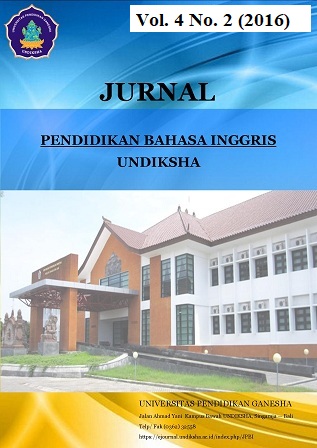AN ANALYSIS OF CLASSROOM INTERACTION IN THE PROCESS OF ENGLISH TEACHING AND LEARNING IN THE TENTH GRADE EFL CLASSES IN SMK NEGERI 1 SUKASADA 2016
DOI:
https://doi.org/10.23887/jpbi.v4i2.8756Abstract
Penelitian ini bertujuan untuk menggambarkan jenis-jenis interaksi kelas dan jenis-jenis tindakan yang digunakan oleh seorang guru bahasa Inggris dan siswa. Penelitian ini menggunakan model interaksi kelas teori I-R-F oleh Sinclair dan Choulthad dengan subjek penelitian guru bahasa Inggris dan siswa kelas sepuluh SMK Negeri 1 Sukasada. Teknik pengumpulan data menggunakan rekaman video, lembar observasi, dan wawancara yang akan dijelaskan secara kualitatif berdasarkan teori IRF. Hasil dari penelitian menunjukan ada sembilan jenis interaksi kelas yang digunakan oleh guru dan siswa, yaitu: Question, Direction, Response, Prompt, Ignore, Encouragement, Criticize, Inform, dan acknowledgement. Comment dan invitation tidak ditemukan dari jenis-jenis interaksi kelas. Ada sepuluh jenis tindakan dalam interaksi kelas yang digunakan oleh guru dan siswa yaitu: Elicitation, Check, Directives, Reply, Prompt, Informative, Comment, Clue, Nomination, Accept.kan oleh guru dan siswa, yaitu: Question, Direction, Response, Prompt, Ignore, Encouragement, Criticize, Inform, dan acknowledgement. Comment dan invitation tidak ditemukan dari jenis-jenis interaksi kelas. Ada sepuluh jenis tidakan dalam interaksi kelas yang digunakan oleh guru dan siswa yaitu: Elicitation, Check, Directives, Reply, Prompt, Comment, Clue, Nomination, dan Accept.Kata Kunci : Interaksi kelas, Teori IRF
This study aims to describe the types of classroom interaction and types of act used by an English teacher and students at SMK Negeri 1 Sukasada. In analyzing the data I-R-F model of classroom interaction study by Sinclair and Choulthard theory was used. The subjects of this study were the English teacher and the tenth grade students of SMK Negeri 1 Sukasada. The data were collected by using video recording, observation sheet and also interview guide. The data were described qualitatively based on IRF theory. The study found nine types of classroom interaction used by the English teacher and students, namely: Question, Direction, Response, Prompt, Ignore, Encouragement, Criticize, Inform, and acknowledgment. Comment and invitation were not found in types of classroom interaction. Besides, ten types of act used by the English teacher and the students, namely: Elicitation, Check, Directives, Reply, Prompt, Informative, Comment, Clue, Nomination, and Accept.
keyword : Classroom Interaction, IRF theory
Published
2016-11-03
Issue
Section
Articles
License
Authors who publish with the Jurnal Pendidikan Bahasa Inggris Undiksha agree to the following terms:- Authors retain copyright and grant the journal the right of first publication with the work simultaneously licensed under a Creative Commons Attribution License (CC BY-SA 4.0) that allows others to share the work with an acknowledgment of the work's authorship and initial publication in this journal
- Authors are able to enter into separate, additional contractual arrangements for the non-exclusive distribution of the journal's published version of the work (e.g., post it to an institutional repository or publish it in a book), with an acknowledgment of its initial publication in this journal.
- Authors are permitted and encouraged to post their work online (e.g., in institutional repositories or on their website) prior to and during the submission process, as it can lead to productive exchanges, as well as earlier and greater citation of published work. (See The Effect of Open Access)













